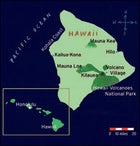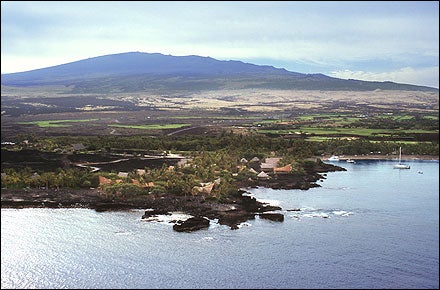WHEN YOU COME TO THE ISLAND OF HAWAII, plan on skipping happy hour. Watching the sun set with your feet up, umbrella drink in hand, may be the way to end your day on Maui, but not here. The Big Island, home to a host of geologic superlativestallest mountain on earth (Mauna Kea, 33,476 feet when measured from the ocean floor), largest active volcano (Mauna Loa), one of the most active volcanoes on the planet (Kilauea)as well as to Pele, temperamental goddess of fire, begs to be taken more seriously than your standard-issue tropical isle. Who cares about sipping mai tais when you can watch manta rays undulate in the deep, witness the fiery red trickle of lava into the Pacific, or see a universe of stars at 12,000 feet? The Big Island has awesome nightlife like no other.
Big Island Hawaii

Ray Ballet
DIVE-HEADS THE WORLD OVER flock to Hawaii to see manta rays beneath the waves by night. Being underwater after dark is eerie even on a shallow protected reef. But here, just off Kailua-Kona, on the island’s west coast, as I slowly descend with my fellow night owls, I try to forget I’m swimming along the slope of a volcano in the middle of the Pacific. Hawaii calls itself the most isolated archipelago on the planet; it’s hard to get farther away from the world’s continents. At 35 feet we reach the rock-and-coral-strewn bottom.
We form a loose circle, switch on our dive lights, and angle them up toward the surface like we’re prepping for a Hollywood premiere. Staring up at the bright spot where the beams intersect, we wait for the storm of tiny shrimplike organisms that are attracted by the light. Minutes after the water turns snowy with plankton, the mantas fly in from the depths.It’s impossible not to imagine them as spacecraft, with their aerodynamic lines and tipped wings. Their rectangular mouths open so wide you can see clear inside their bodies. They cruise slowly over our heads into the middle of their meal, performing elegant backflips. There’s never any guarantee that these huge, harmless creatures will show up. But tonight there are easily a dozen, some with 12-foot wingspans. I feel something slither over my handa green moray eel on the hunt. A few feet away, he gobbles a butterfly fish whole.
On Pele’s Trail
ALTHOUGH THE Puu Oo vent of Kilauea has been erupting fairly steadily since 1983, making a pilgrimage to view the flowing lava demands patience and a degree of humility; this is Pele’s turf, and no one knows from one day to the next exactly where the lava will be flowing.
When I arrive in the late afternoon at Hawaii Volcanoes National Park, the upper elevations are shrouded in vog (volcanic smog) and clouds. Visibility: my toes. At the end of the 19-mile Chain of Craters Road, where you park your car and begin to hike, there’s a sign at the ranger station. It usually reads, BE PREPARED FOR A SHORT HOT HIKE, but someone has taped LONG over SHORT. Still, I’m game. What’s a seven-mile hike in the dark (and I mean dark; no major-city lights for 2,500 miles) over recently cooled lava that sometimes breaks underfoot, causing you to scream as if you are falling to the center of the earth?
The hike is an awkward stumble over miles of aa, the chunky sharp stuff that can slice right through your trail runners, and pahoehoe, the glossy, glassy stuff that looks like burned brownie batter. We faithful begin trudging along in a silent, wiggly line. It starts to rain. My flashlight, which looked so authoritative and powerful on the seat of my rental car, shines a feeble dime of light on the black ground. Someone trips and falls and says, “Shit, sorry.” The desolation is staggering; the lava beds go on for miles. People get lost out here from time to time. Last July, Gilbert Gaedcke, of Austin, Texas, disappeared for five days, surviving on water squeezed from moss. He was eventually rescued when a teenager in a tour helicopter happened to spot him.
The downpour sent a bunch of us bolting for cover at the ranger station, but those who completed the pilgrimage eventually saw glowing ribbons in the distance, dribbling over the rocks into the ocean, sending pale plumes of steam up into the night. They said the lava looked first like fire transformed into hot fudge, then like some sentient being out of a fifties sci-fi flick.
Star Trek
MAUNA KEA IS MECCA for astronomers. It’s the best piece of real estate on the planet for viewing the heavensover the course of the year, it’s possible to see 100 percent of the Northern Hemisphere sky and 70 percent of the Southern Hemisphere’s. Here, it’s possible to see the Southern Cross and the North Star at the same time. You can make the trip to the 13,796-foot summit on your own, but there are several tour companiesHawaii Forest & Trail is a good onethat will do the driving, provide you with a parka and gloves (necessary for the 40-degree temperature), feed you dinner, and, most important, give you access to a portable nine-inch telescope.
The air is thin enough at the top to make me feel as if I’ve had a cocktail or three. The summit is a collection of cinder cones: One is home to 13 telescopes, the most expensive collection in the world, and the other, slightly higher in elevation, is a Hawaiian sacred site, the traditional meeting place of Wakea, the sky god, and Papa, the earth mother. There is a modest altar atop this cone, and our guide discourages us from hiking up to see it, out of respect.
After the sun goes down, we set up our viewing area at the side of the road at about 12,000 feet. Shivering in the darkness, our small group mills around as each person takes a turn peering through the telescope. The triple-star system of Alpha Centauri, usually visible only from the Southern Hemisphere, winks blue-red-orange-purple-green, a stellar disco ball.
As we pack up our things for the return to sea level, a huge meteor blazes into the atmosphere and sails briskly over our heads. The burning orange ball is clearly distinguishable from its pale yellow tail. It tears a bright line across the sky before breaking apart and fading to black near the horizon.
“Oh, my God, oh, my God!” we shriek idiotically. Our guide, who makes the trip to the summit four times a week, shares the awe. “The normal shooting stars we see up here are the size of a grain of sand,” he says. “That thing was as big as a football. This was probably the sighting of a lifetime.”
GETTING THERE AND AROUND:
Hawaiian Airlines (800-367-5320, ) and Aloha Airlines (800-367-5250, ) fly nonstop to the Big Island’s Kona International Airport from major western U.S. cities, including Las Vegas, Los Angeles, San Francisco, Oakland, and Seattle; round-trip airfare from Los Angeles on Hawaiian starts around $560. Most major car-rental agencies have offices at the airport. The weekly rate for a midsize rental from Dollar (866-434-2226, ) is $245. A four-wheel-drive Jeep Grand Cherokee will run you $413 per week.
WHERE TO STAY AND EAT: The Kohala Coastthe island’s northwestern coast, north of the airportoffers the sunniest skies, the most beautiful white-sand beaches (Hapuna and Mauna Kea), and a string of posh resorts. Top of the line is the Four Seasons Resort Hualalai (doubles, $625$925; 888-340-5662, ), a thoroughly buttoned-down 32-acre spread with 243 guest rooms and suites in two-story bungalows, all done up in stone tiles and dark wood, with private lanais (porches); an 18-hole golf course; three upscale restaurants; four pools (where staff pop by to ask if they can clean your sunglasses); and a state-of-the-art spa with lap pool. On Saturday nights, the Surf, Sand, and Stars barbecue, with tables set up on the beach, is an orgy of lobster tails, baby back pork ribs, and steamed clams. Afterwards, head to the ocean-view Lava Lounge for a fruity nightcap.
A ten-minute stroll down the beach (where you’re likely to find sea turtles sunning in the late afternoon) is Kona Village Resort (doubles, $580, including meals; 800-367-5290, ), a Polynesian fantasy of 125 secluded thatch-roofed bungalows, or hales, cooled by ceiling fans. Word of mouth credits the 82-acre resort with the island’s most authentic ahaaina, or luau (Friday nights; $89 per adult for nonguests); think mounds of imu-roasted pork, grass skirts, and beating drums.
Farther north up the coast is the 540-room Fairmont Orchid (doubles from $329; 800-441-1414, orchid), a stately, six-story U-shaped building shrouded in a jungle of palms and bamboo surrounding a meandering swimming pool. Head first to the Orchid Beach Club, down by the sandy lagoon, where beachboys dispense all manner of kayaks, surfboards, boogie boards, and snorkeling gear. Sign on to hike with charismatic beachboy “Uncle” Gary Medina to see petroglyphs or learn to paddle a traditional outrigger canoe. In the evening, settle in at Brown’s Beach House for exquisite fresh seafood, such as crab-crusted opakapaka (local pink snapper) in sake-mirin butter sauce.
Since the Kohala Coast is relatively quiet, you may opt to stay closer to the frenzy of KailuaKona, south of the airport. The Sheraton Keauhou Bay Resort & Spa (doubles from $209; 888-488-3535, ), which opened after massive renovations a year ago, is a whitewashed hulk set on landscaped grounds right on the lava-strewn coast; a 14,000-square-foot pool with a 200-foot waterslide makes up for the lack of beach. Huggo’s on the Rocks (808-329-1493, ), in the heart of Kona, is a sand-floored outdoor oasis for watching the sunset, listening to live music, and sipping mixed cocktails.
If you’re planning an evening hike to flowing lava in Hawaii Volcanoes National Park, plan on spending the night halfway around the island on the southeastern coast. Kilauea Lodge (doubles, $140; 808-967-7366, ), in the tiny village of Volcano, was built as a YMCA camp in 1938 and still retains that going-to-camp feeling. In a residential area right outside the park, you’ll find the Inn at Volcano (doubles, $139$399; 800-937-7786, ), with five rooms and a stand-alone suite gussied up with marble accents and Victorian frills, plus a three-course candlelight breakfast served on fine china.
NIGHTTIME EXPLORING: The guys at Jack’s Diving Locker say there’s an 80 percent chance of seeing manta rays on one of their outings ($115 per person; 800-345-4807, ); the boat departs five nights a week for a one-tank dive prior to the manta-ray night dive. Hawaii Volcanoes National Park‘s visitor center offers general information about where the lava is flowing, but don’t expect it to be dead-on accurate. From day to day, it’s anyone’s guess. Park information: 808-985-6000, . Hawaii Forest & Trail ($165 per person, including dinner, parka, gloves, and transportation; 800-464-1993, ) runs stargazing trips to Mauna Kea daily.
RESOURCES The best guidebook, with lots of maps and the inside scoop, is Hawaii: The Big Island Revealed , by Andrew Doughty and Harriett Friedman (Wizard, $16). For extensive information on the Big Island, go to .


